- Books Name
- ACME SMART COACHING Biology Book
- Publication
- ACME SMART PUBLICATION
- Course
- CBSE Class 11
- Subject
- Biology
Long Distance Transport Of Water
The amount of water that can be held by soil, depends upon the total pore space in the soil.
Water is present in the spaces between the soil.
The total amount of water present in soil is called Holard.
The water available to plants is Chresard.
The rest of soil water is called Echard.
Concept Builder
Various types of ground water are:
(i) Run off water : Water which flows along the surface of soil and reaches to the nearest water body constitute run off water. This water is not available to the plants.
(ii) Gravitational water: Water Which percolates down through the soil macropores (20-50mm diameter) under the influence of gravity and reaches the water table is called gravitational water. This type of water is also not available to the plants.
(iii) Capillary water: Water retained by soil micropores. (£ 20 mm diameter) in the form of fine capillaries constitutes capillary water. This type of water is available to the plants.
(iv) Hygroscopic water: Water held in form of a very thin film around the soil particles by the forces of absorption constitutes hygroscopic water. This type of water is not available to the plant.(v) Chemicaliy combined water: Water which combines with inorganic salts of the soil in the form of water of hydration constitutes chemically combined water. This type of water is also not available to the plants.
(vi) Water vapours: They are present in soil air spaces, Normally, they are not available to the plants. Under certain conditions they are useful in the phenomenon of night recovery.
Water Absorption and Pathway of Water Across the Root
Water absorbing structure of the plant is root hair zone. Root hair is tubular prolongation of epiblema cells.
Root hairs are unicellular, short lived and arranged in an acropetal manner.
Root hairs are found in zone of cell maturation.
During transplantation the root hairs are removed, that is why, the plant remains wilted in the new habitat.
The cell wall of root hair is made up of two layers.
The outer wall is of pectin which dissolves in water, so that root hair surface becomes slimy and sticky.
The inner wall is made up of cellulose.
They are about 10 µm in diameter.
There OP is higher (3 - 8 atm) as compared to soil solution (less than 1 atm.
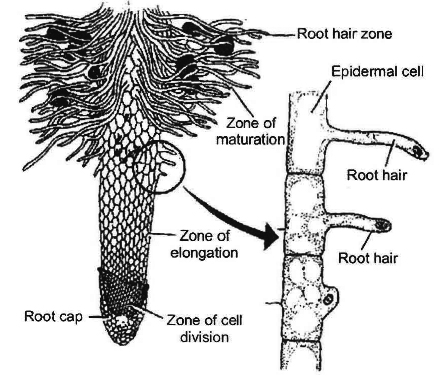
Many forest trees, shrubs and some conifers have scanty root hairs so they make association with the fungi, called mycorrhiza.
Orchid roots have a specific type of tissue for absorbing environmental moisture, this tissue is called velaman tissue.
Movement of water from root hair cell to xylem may occur by two possible paths:
1. Apoplast Pathway: In this method, water passes from root hair cell to xylem through the walls of intervening cells without crossing any membrane or cytoplasm. The apoplastic movement of water beyond/ cortex is blocked due to the presence of casparian strips in the endodermal cells. Major movement of water through cortical cells occurs by this method, as cortical cells offer least resistance.
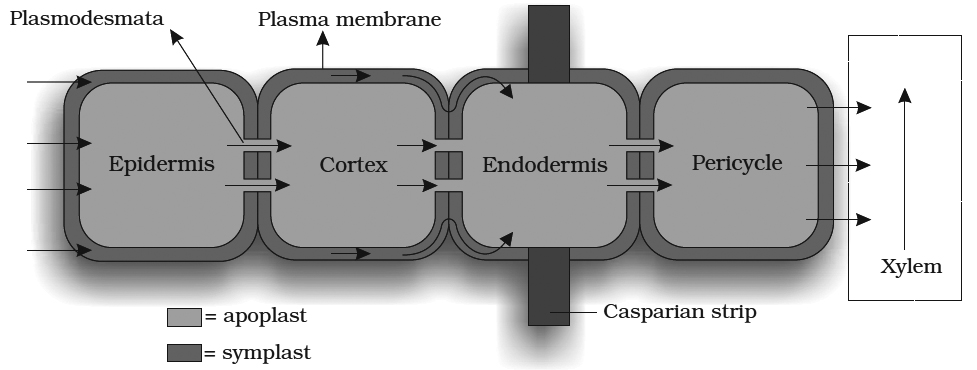
2. Symplast Pathway: In this method, water passes from cell to cell by crossing plasma membrane, therefore it is also known as transmembrane pathway. This may occur by two methods:
(i) Non Vacuolar Symplast Pathway: In this method, water passes between adjacent cells through plasmodesmata. It does not enter into the vacuoles.
(ii) Vacuolar Symplast Pathway: In this method, water crosses the tonoplast, surrounding the vacuole. This pathway offers a lot of resistance.
Beyond cortex (through endodermis and pericycle ) water is forced to move through symplast pathway. Terms Apoplast and Symplast were proposed by "Munch".
Mechanism of Water Absorption
(1) Passive absorption of water:
In actively transpiring plants, absorption of water takes place due to the forces developed at the transpiring surface of the plant (i.e., transpiration pull).
In this type, the cells of the root do not play any part, and it does not consume energy, hence it is known as passive absorption.
Thus in passive absorption, water is just pulled through the roots.
This is the most common (96%) and rapid method of water absorption.
Generally water is absorbed by the root hairs when the osmotic concentration of their sap is high.
This is made possible by transpiration taking place in the aerial parts of the plant.
It continously removes water from the sap of the root hairs which, in turn, are in contact of the soil water.
In actively transpiring plants, water loss from mesophyll cells occurs and increases their osmotic concentration.
It also results in the increase of their DPD.
As a result, water from neighbouring cells enters in them by osmosis.
These cells in turn have now increased their osmotic concentration or lowered their water potential.
Hence, water enters into them by osmosis from other adjacent cells.
In this way, mesophyll cells draw water from one another along the suction pressure gradient or DPD till it reaches the xylem of the leaf.
Once water is drawn from xylem of the leaf, the entire water column in the xylem of the leaf, stem and the root is lifted.
The movement of water is apoplastic.
In this way water is absorbed by the root hair due to diffusion pressure deficit gradient produced by transpiration that develops in the leaf.
Root simply acts as a path of water.
(2) Active absorption of water:
Although a very small amount of water (4%) is absorbed by active mechanism, it involves an expenditure of metabolic energy which comes from the respiring cells of the root.
Roots are actively involved in this method, so it is absorption by the roots.
Active absorption of water may occur in one of the two ways-(i) osmotic, (ii) non-osmotic.
Water absorption from soil and its inward movement is OP dependent or independent (OP of root hairs is higher than soil solution, OP of cortical cells is higher than root hairs).
Passage of water from living cells to xylem channel requires accumulation of solute in xylem which is an energy dependent process.
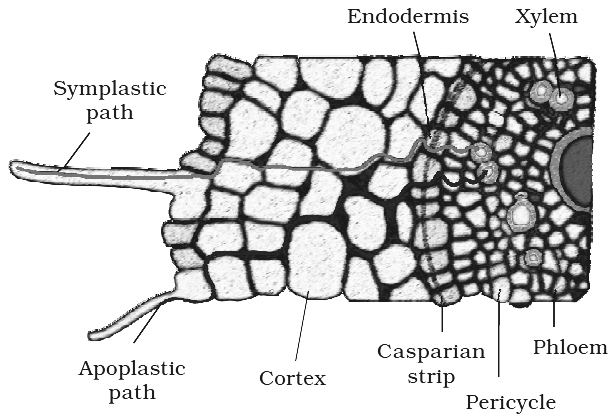
Hence, pumping of water in xylem channel is active.
This creates a positive pressure in xylem called root pressure.
Certain evidences also favour non osmotic absorption of water, requiring energy.
Difference between Passive and Active Absorption
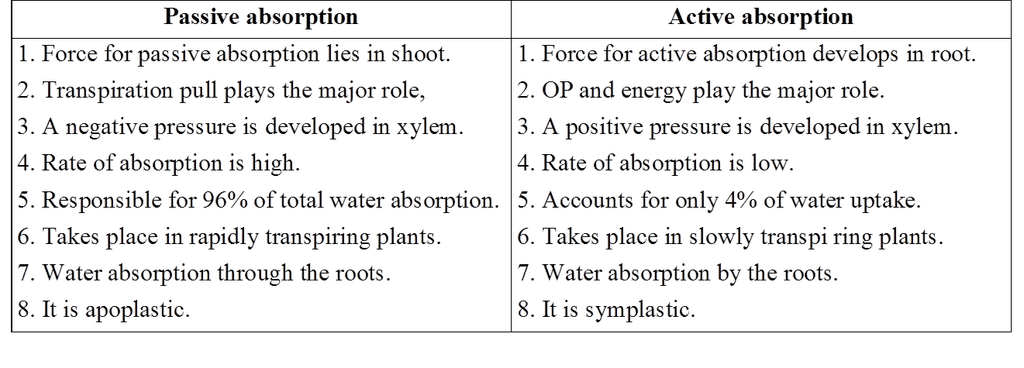
Factors affecting water absorption
(1) Available soil water. Absorption of water is more, if the amount of available water is more. Rate of water absorption decreases, if the amount of soil water is below permanent wilting percentage or beyond field capacity.
(2) Soil air. Absorption of water takes place at a rapid rate in well aerated soil. Oxygen deficiency retards the growth of roots, thus inhibiting absorption of water. In the soil, if all the air spaces are filled with water the condition is known as water logging of soil. Such soil is physiologically dry soil.
(3) Concentration of soil solution. If the soil solution is highly concentrated due to the presence of salts, it will inhibit the water absorption. It is also a kind of physiological dryness.
(4) Soil temperature. An increase in soil temperature upto about 30°C favours water absorption. At higher temperatures water absorption is decreased and at O°C it is almost checked.
ASCENT OF SAP
Upward conduction of water in the form of dilute solution of mineral ions from roots to aerial parts is called ascent of sap.
Xylem is responsible for ascent of sap which can be proved by girdling experiment.
Concept Builder
Girdling or ringing experiment
Ringing expedmentwas first introduced by Malpighi (father of microscopic anatomy).
It consists of removing a ring of bark, i.e., all the tissues outside vascular cambium.
During Girdling or ringing experiment, two s mall twigs are taken.
Girdle or a ring of bark is removed from one of these twigs by a sharp knife.
In second twig, xylem is removed carefully without causing much injury to the bark or xylem can be blocked with wax.
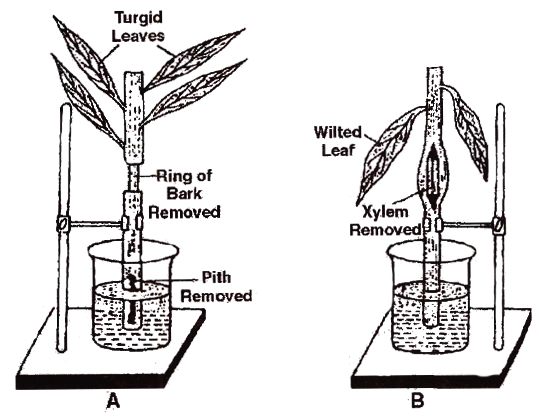
Determination of path of ascent of sap
A. Shoot with removed bark and leaves remains turgid.
B. Shoot with removed xylem Shows wilting of leaves.
Thus, the girdled part of the first twig contains only xylem and that of the second twig has all tissues except xylem.
Both the twigs we placed in separate beakers containing water.
After a period of time, leaves on the first twig appear turgid while those on the second/twig with no or blocked xylem, the leaves wilt.
This experiment shows that water conduction occurs through the xylem.
Mechanism of ascent of sap
Many theories were put forward to explain the mechanism of ascent of sap. These theories are placed in following three categories:
(1) Vital force theories
(2) Root pressure theory
(3) Physical force theories
Concept Builder
(1) Vital force theories
According to these theories, living cells are responsible for ascent of sap. Some of the important vital force theories are given below:
(a) Wastermaier concept: He suggested that the living component of xylem, i.e., xylem parenchyma is responsible for the conduction of water, while the tracheids and vessels act as a water reservoir.
(b) Godlewski's relay pump theory or clambering theory : According to this theory, conduction of water occurs due to activity of xylem parenchyma and medullary rays. It is believed that some rhythmic change occurs in the osmotic pressure of these cells. When their osmotic pressure is high, water is absorbed from the surrounding vessels, so the turgor pressure of these cells increases. Hence; the water is pumped to next level of xylem vessels, in a stair case like manner.
(c) Sir J.C. Bose's pulsation theory: He experimented on Indian telegraph plant (Desmodium gyrans). By the help of electric probe, he believed that the pulsation movement occurs in the cortex cells which are present just outside the endodermis, which is responsible for ascent of sap, but such pulsations were not found to be of universal occurrence.
(2) Root pressure theory
When a potted plant is cut below the first leaf and manometer filled with water is attached on cut stem, the level of water in manometer increases.
It indicates that water is being pushed by roots after it is absorbed.
If a stem is cut near its base or incision is mad e into a plant, xylem sap is seen to flow out.
This phenomenon is known as exudation or bleeding.
Priestley stated Stand that the upward flow of water in bleeding is due to root pressure.
Stephan Hales coined the term root pressure and described it as "The hydrostatic pressure developed in roots due to accumulation of water absorbed by the roots".
The development of root pressure is the result of an active absorption.
This depends upon the active accumulation of solute in xylem sap.
This can be inhibited using cyanide, lack of O2 and low temperature.
(1) Root pressure can generate pressure of about 2 atm which is insufficient to raise the water up in tall trees.
(2) In some plants like conifers, root pressure has never been observed.
(3) In temperate regions, root pressure is generally low du ring summer when the rate of transpiration is high, in comparison to absorption.
(4) Ascent of sap continues even in the absence of root pressure.
(5) The greatest contribution of root pressure may be to re-establish the continuous chain of water molecules in the xylem, which often break under the enormous tensions created by transpiration.
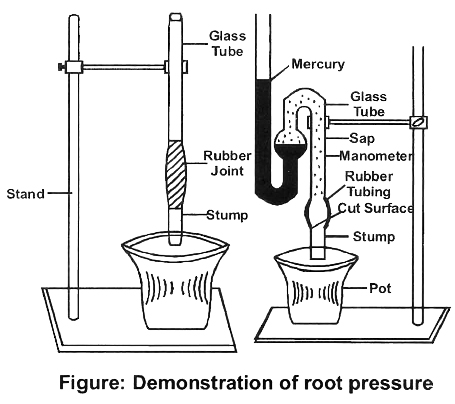
(3) Physical force theories
According to the proponents of physical force theories, living cells do not take part in the translocation of water, but is brought about by some physical forces developing in the dead cells.
Some of the physical force theories are described in brief:
(a) Capillarity theory: According to Boehm, water moves upward partly due to capillaries of the vessel elements and partly due to atmospheric pressure.
The theory could not be accepted because of the following points:
(i) For capillary action, the capillary should be in contact with the free water surface, however, in plants, xylem is not in direct contact with the soil water.
(ii) Capillary action can be observed only in narrow vessels, but tall plants usually have wider vessels (0.03 mm diameter).
(b) Imbibition theory: According to Sachs, water moves upward due to imbibitional force between the cell wall of the xylem and not through the lumen of xylem vessels.
(c) Cohesive force and transpiration pull theory or Cohesion tension theory : This is the most widely accepted explanation for ascent of sap. It was proposed by Dixon and Jolly (1894). The theory is based essentially upon following three facts
(i) Cohesive force or tensile strength of water. The water molecules have a strong mutual attraction, i.e., they tend to 'stick' to each other. This is called cohesion. They also tend to stick to the lignocellulosic wall of the xylem elements; this is called adhesion. A high cohesion of water molecules means that a relatively large tension is required to break a column of water. The magnitude of tensile strength of water is 10-30 MPa.
(ii) Continuity of water column. Water forms a continuous column from the leaves to the roots. The cohesive and adhesive forces are very great and do not allow the water column to break or pull away from the walls of the xylem.
(iii) Transpiration pull. Water evaporates from mesophyll cells of the leaf due to transpiration. This results in an increase in their diffusion pressure deficit (DPD) or suction pressure. Since the water in the mesophyll cells is in contact with xylem sap of stem and roots through tracheids in the veins, the diffusion pressure gradient gradually passes down to the xylem of the root (negative pressure) and water is pulled up. Thus due to transpiration, there is a constant pull or tension on water column in upward direction. This is called transpiration pull or tension in the water column of xylem due to transpiration.
Water potential as low as (-3 MPa or -30 bars) has been measured in the leaves borne on tree tops.
This can overcome gravitational pull and resistance offered by the capillaries of xylem vessels.
The theory assumes tracheids to be more efficient than vessels.
They believed that partition walls of the tracheids confer stability on the stressed transpiration stream.

 ACME SMART PUBLICATION
ACME SMART PUBLICATION
